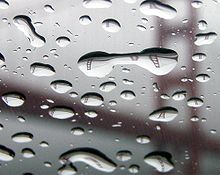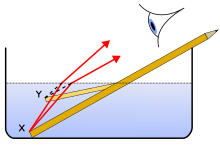వక్రీభవనం


వక్రీభవనం అనగా తరంగములు ప్రసార యానకంలో వాటి దిశను మార్చుకొనే దృగ్విషయము. వక్రీభవనం అనునది ముఖ్యంగా ఉపరితల దృగ్విషయము. ఈ దృగ్విషయం ముఖ్యంగా శక్తి నిత్యత్వ నియమం, ద్రవ్యవేగం పై ఆధారపడుతుంది. యానకం మారినందువల్ల తరంగం యొక్క దశా వేగం మారుతుంది కానీ దాని పౌనఃపున్యం మారదు. ఇది ఒక తరంగం యానకం నుండి వేరొక యానకం లోనికి 90° లేదా 0° కాని ఏదైనా కోణంలో ప్రయాణించినపుడు ఈ దృగ్విషయాన్ని మనం సాధారణంగా గమనించవచ్చు. కాంతి వక్రీభవనం అనునది అతి సాధారణంగా మనం గమనించే దృగ్విషయం. కానీ ఏ తరంగమైనా ఒక యానకం నుండి వేరొక యానకం లోనికి ప్రవేశించినపుడు వక్రీభవనం చెందుతుంది. ఉదాహరణకు ధ్వని తరంగం ఒక యానకం నుండి వేరొక యానకం లోనికి ప్రవేశించినపుడు లేదా నీటిపై యేర్పడిన తరంగాలు అధిక లోతు గల ప్రదేశం నుండి అల్ప లోతు గల ప్రదేశం వైపుకు ప్రయాణించినపుడు ఈ దృగ్విషయం జరుగుతుంది.
వక్రీభవనం అనునది స్నెల్ నియమం ప్రకారం వివరించబడుతుంది. ఈ నియమం ప్రకారం ఇచ్చిన యానకాల జత, ఒకే పౌనః పున్యము గల తరంగం ఉన్నపుడు పతన కోణం θ1, వక్రీభవన కోణంθ2 ల సైన్ల నిష్పత్తి, వాటి దశా వేగాల నిష్పత్తికి (v1 / v2) రెండు యానకాలలో కూడా సమానంగా ఉంటుంది. లేదా వాటి వక్రీభవన సూచికల విలోమ నిష్పత్తికి (n2 / n1) సమానంగా ఉంటుంది.
సాధారణంగా పతన తరంగం పాక్షికంగా వక్రీభవనం చెంది, పాక్షికంగా పరావర్తనం చెందితే; దాని ప్రవర్తన యొక్క వివరాలు ప్రెస్నెల్ సమీకరణము ద్వారా వివరించవచ్చు.
వివరణ
[మార్చు]
దృశా శాస్త్రంలో ఎప్పుడైతే తరంగం ఇచ్చిన వక్రీభవన గుణకం గల యానకం నుండి ఏటవాలు కోణంతో వేరొక యానకంలోనికి ప్రయాణించినపుడు వక్రీభవనం అనే దృగ్విషయం సంభవిస్తుంది. యానకాల మధ్య సరిహద్దు ప్రదేశంలో తరంగం యొక్క దశా వేగం మారుతుంది. అందువల్ల తరంగం దాని దిశను మార్చుకుంటుంది. దాని తరంగ దైర్ఘ్యం పెరుగుతుంది లేదా తగ్గుతుంది కానీ దాని యొక్క పౌనః పున్యము మాత్రం స్థిరంగా ఉంటుంది. ఉదాహరణకు ఒక కాంతి కిరణం వక్రీభవనం చెందినపుదు అది గాజు గుండా ప్రవేశించి వెలుపలికి బహిర్గతమైనపుడు దాని వక్రీభవన గుణకంలో మార్పు వస్తుంది. ఒక కిరణం లంబం (తలానికి గీయబడిన లంబం) గుండా పోయినపుడు దాని వేగం మారుతుంది కానీ దాని దిశ మారదు. ఈ సందర్భంలో వక్రీభవనం జరుగుతుంది. ఈ భావనను అర్థం చేసుకొనుట కటకము ల ఆవిష్కరణకు దోహదపడింది. దీని ఫలితంగా వక్రీభవన టెలిస్కోప్ తయారైనది.

ఒక పాత్రలోని నీటిలో వక్రీభవనం దృగ్విషయాన్ని పరిశీలించవచ్చు. గాలి యొక్క వక్రీభవన గుణకం సుమారు 1.0003 ఉంటుంది. నీటి యొక్క వక్రీభవన గుణకం సుమారు 1.3330 ఉంటుంది. ఒక వ్యక్తి ఒక వస్తువును (ఒక పెన్సిల్ లేదా స్ట్రా) నేరుగా చూసినపుడు, అది ఏటవాలుగా ఉన్నప్పుడు దానిలో కొంతభాగం నీటిలో ఉన్నపుడు అది నీరు, గాలి సరిహద్దు వద్ద వంగినట్లు కనిపిస్తుంది. ఎందువల్లనంటే కాంతి కిరణాలు నీటినుండి గాలిలోనికి వచ్చినపుడు వంగి ప్రయాణిస్తారు. ఒకసారి ఆ కిరణాలు మన కంటికి చేరినపుడు, కన్ను వాటిని సరళరేఖలుగా (దృష్టి రేఖలు) గుర్తిస్తుంది. ఈ దృష్టి రేఖలు (పటంలో చుక్కల రేఖలతో చూపబడినవి) వస్తవ కిరణాల ఖండన బిందువు కన్నా ఉన్నత స్థానం వద్ద ఖండిచుకొనినట్లు కనిపిస్తాయి. అందువలన పెన్సిల్ ఎత్తుగా ఉన్నట్లు కనిపిస్తుంది, నీరు వాస్తవం కంటే దిగువగా ఉన్నట్లు కనబడుతుంది. నీటి లోతు పాత్ర లోతుకంటే పైకి ఉన్నట్లు కనిపిస్తుంది.
This is an important consideration for spearfishing from the surface because it will make the target fish appear to be in a different place, and the fisher must aim lower to catch the fish. Conversely, an object above the water has a higher apparent height when viewed from below the water. The opposite correction must be made by an archer fish.[1] For small angles of incidence (measured from the normal, when sin θ is approximately the same as tan θ), the ratio of apparent to real depth is the ratio of the refractive indexes of air to that of water. But as the angle of incidence approaches 90o, the apparent depth approaches zero, albeit reflection increases, which limits observation at high angles of incidence. Conversely, the apparent height approaches infinity as the angle of incidence (from below) increases, but even earlier, as the angle of total internal reflection is approached, albeit the image also fades from view as this limit is approached.

The diagram on the right shows an example of refraction in water waves. Ripples travel from the left and pass over a shallower region inclined at an angle to the wavefront. The waves travel slower in the more shallow water, so the wavelength decreases and the wave bends at the boundary. The dotted line represents the normal to the boundary. The dashed line represents the original direction of the waves. This phenomenon explains why waves on a shoreline tend to strike the shore close to a perpendicular angle. As the waves travel from deep water into shallower water near the shore, they are refracted from their original direction of travel to an angle more normal to the shoreline.[2] Refraction is also responsible for rainbows and for the splitting of white light into a rainbow-spectrum as it passes through a glass prism. Glass has a higher refractive index than air. When a beam of white light passes from air into a material having an index of refraction that varies with frequency, a phenomenon known as dispersion occurs, in which different coloured components of the white light are refracted at different angles, i.e., they bend by different amounts at the interface, so that they become separated. The different colors correspond to different frequencies.
While refraction allows for phenomena such as rainbows, it may also produce peculiar optical phenomena, such as mirages and Fata Morgana. These are caused by the change of the refractive index of air with temperature.
The refractive index of materials can also be nonlinear, as occurs with the Kerr effect when high intensity light leads to a refractive index proportional to the intensity of the incident light.
Recently some metamaterials have been created which have a negative refractive index. With metamaterials, we can also obtain total refraction phenomena when the wave impedances of the two media are matched. There is then no reflected wave.[3]
Also, since refraction can make objects appear closer than they are, it is responsible for allowing water to magnify objects. First, as light is entering a drop of water, it slows down. If the water's surface is not flat, then the light will be bent into a new path. This round shape will bend the light outwards and as it spreads out, the image you see gets larger.

An analogy that is often put forward to explain the refraction of light is as follows: "Imagine a marching band as they march at an oblique angle from pavement (a fast medium) into mud (a slower medium). The marchers on the side that runs into the mud first will slow down first. This causes the whole band to pivot slightly toward the normal (make a smaller angle from the normal)."
వైద్య పరమైన ప్రాముఖ్యత
[మార్చు]In medicine, particularly optometry, ophthalmology and orthoptics, refraction (also known as refractometry) is a clinical test in which a phoropter may be used by the appropriate eye care professional to determine the eye's refractive error and the best corrective lenses to be prescribed. A series of test lenses in graded optical powers or focal lengths are presented to determine which provides the sharpest, clearest vision.[4]
శబ్ద శ్రవణ శాస్త్రం
[మార్చు]In underwater acoustics, refraction is the bending or curving of a sound ray that results when the ray passes through a sound speed gradient from a region of one sound speed to a region of a different speed. The amount of ray bending is dependent upon the amount of difference between sound speeds, that is, the variation in temperature, salinity, and pressure of the water.[5] Similar acoustics effects are also found in the Earth's atmosphere. The phenomenon of refraction of sound in the atmosphere has been known for centuries;[6] however, beginning in the early 1970s, widespread analysis of this effect came into vogue through the designing of urban highways and noise barriers to address the meteorological effects of bending of sound rays in the lower atmosphere.[7]
చిత్రమాలిక
[మార్చు]-
Refraction in a Perspex (acrylic) block.
-
The straw appears to be broken, due to refraction of light as it emerges into the air.
-
Photograph of refraction of waves in a ripple tank.
-
Refraction at a steep angle of incidence
-
Double aort artifact in sonography due to difference in velocity of sound in muscle and fat.
ఇవి కూడా చూడండి
[మార్చు]- Birefringence (double refraction)
- Huygens–Fresnel principle
- List of indices of refraction
- Metamaterials
- Negative refraction
- Parallax, a visually similar principle caused by angle of perspective
- Reflection
- Snell's law
- Total internal reflection
మూలాలు
[మార్చు]- ↑ Dill, Lawrence M. "Refraction and the spitting behavior of the archerfish (Toxotes chatareus)." Behavioral Ecology and Sociobiology 2.2 (1977): 169-184.
- ↑ "Shoaling, Refraction, and Diffraction of Waves". University of Delaware Center for Applied Coastal Research. Archived from the original on 2009-04-14. Retrieved 2009-07-23.
- ↑ Ward, David W; Nelson, Keith A; Webb, Kevin J (2005). "On the physical origins of the negative index of refraction". New Journal of Physics. 7: 213. arXiv:physics/0409083. Bibcode:2005NJPh....7..213W. doi:10.1088/1367-2630/7/1/213.
- ↑ "Eye Glossary". Archived from the original on 2006-05-26. Retrieved 2006-05-23.
- ↑ Navy Supplement to the DOD Dictionary of Military and Associated Terms (PDF). Department Of The Navy. August 2006. NTRP 1-02.[permanent dead link]
- ↑ Mary Somerville (1840), On the Connexion of the Physical Sciences, J. Murray Publishers, (originally by Harvard University)
- ↑ Hogan, C. Michael (1973). "Analysis of highway noise". Water Air and Soil Pollution. 2 (3): 387. doi:10.1007/BF00159677.
బయటి లంకెలు
[మార్చు]- Java illustration of refraction
- Java simulation of refraction through a prism
- Reflections and Refractions in Ray Tracing, a simple but thorough discussion of the mathematics behind refraction and reflection.
- Flash refraction simulation- includes source, Explains refraction and Snell's Law.
- Animations demonstrating optical refraction by QED





